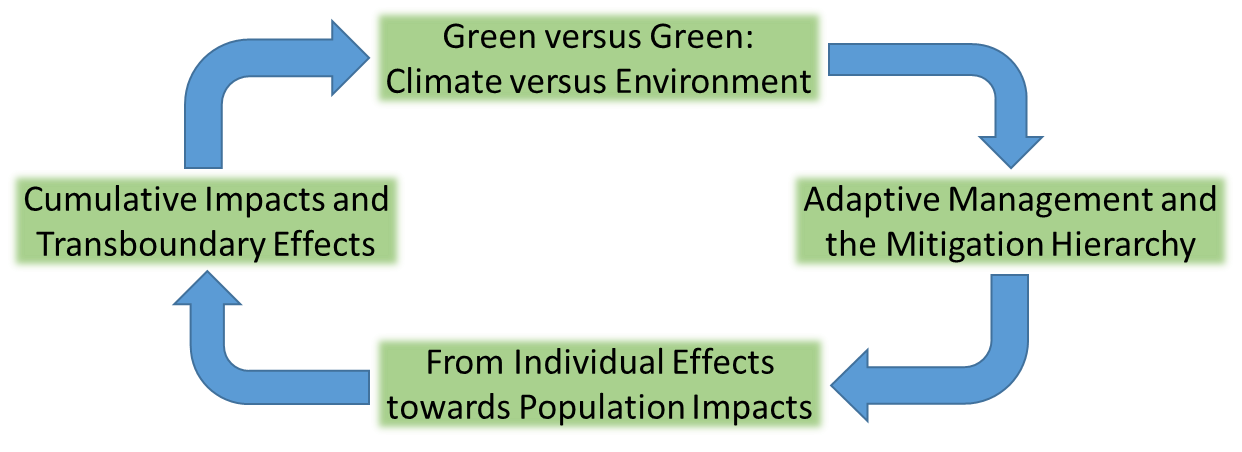International Energy Agency Wind Task 34
Working together to resolve environmental effects of wind energy (WREN)
Concerns over environmental effects of wind energy continue to challenge the wide scale deployment of both offshore and land-based wind projects. The vision of WREN is to form the leading international forum to exchange and disseminate up-to-date, robust knowledge on peer-reviewed scientific research and methods for assessing and monitoring the environmental effects of wind energy development. In order to address these concerns, WREN will develop white papers to focus on and advance the state of understanding on several central issues of global concern within the wind community.
While proponents forward the global benefits of wind energy in reducing CO2 emissions to mitigate climate change, opponents often point to the local costs involved for biodiversity and ecosystem services through land-/seascape changes. This spatio-temporal mismatch between global and long-term public (climate) benefits and local and short-term private (environmental) costs, and the respective negligence of each other’s arguments hampers development. The clue in reconciling such “green versus green” argumentations for and against wind energy development lies therefore in scaling strategic planning and decision-making processes to intermediate spatial and temporal scales. This white paper relates to the first steps of the Mitigation Hierarchy whereby the focus lies on the practical options and concepts to overcome green versus green issues.
Environmental impacts from renewable energy development are usually addressed in the approval process through the “refrain–avoid–minimize–reduce–compensate” Mitigation Hierarchy. To apply the mitigation hierarchy actively throughout a wind energy project’s life cycle, adaptive management has been promoted. Adaptive management is an iterative decision-making tool to plan and manage environmental risks associated with single wind energy projects through targeted monitoring. This white paper will assess the options for applying adaptive management in wind energy projects to mitigate impacts on the environment, including required monitoring at relevant spatial scales.
Environmental conflicts commonly set focus on effects on wildlife within the footprint of single wind energy projects. However, to which extent these observed effects may impact the species at larger spatial scales remains unclear. Current practice so far has not been able to set clear criteria how to go from effects to impacts; where the first relates to objectively/empirically deduced quantities and the latter indicate thresholds what is “acceptable” for society. It also remains difficult to extrapolate local, both direct and indirect, effects to demographic impacts at the population level. This white paper aims at elucidating the linkages between local and population-level effects and providing options for obtaining objective impact thresholds at appropriate spatial scales.
Upgrading from local effects to population-level impacts necessitates agreement across sites as population may well be influenced by several wind energy facilities. Such cumulative impacts has been much debated as to how it should be defined and at what spatial extent it should be studied. Internationally there has been signaled a growing need to establish common standards and methods of how issues related to cumulative effects of wind energy can be integrated in future research and monitoring practice. As biogeographic ranges generally do not follow national borders, these standards need to be adopted internationally and necessitates transboundary collaboration.
These topics are clearly interrelated but operate within different spatial contexts. Green versus green argumentation and regional decision-making sets the premises for adaptive management and to which extent impacts are required to be mitigated at single wind energy projects. The locally monitored effects on wildlife and consequent mitigation measures will require knowledge on how to upgrade towards population impacts at regional to biogeographic levels. This in turn provides input to assessing cumulative impacts at regional to (inter)national scales and necessitating transboundary collaboration across wind energy projects, species and/or infrastructural development. When knowledge on cumulative and transboundary impacts are known, this may iteratively affect how regional decision-makers assess the tradeoff and balance between reducing global climate emissions versus the local environment.
